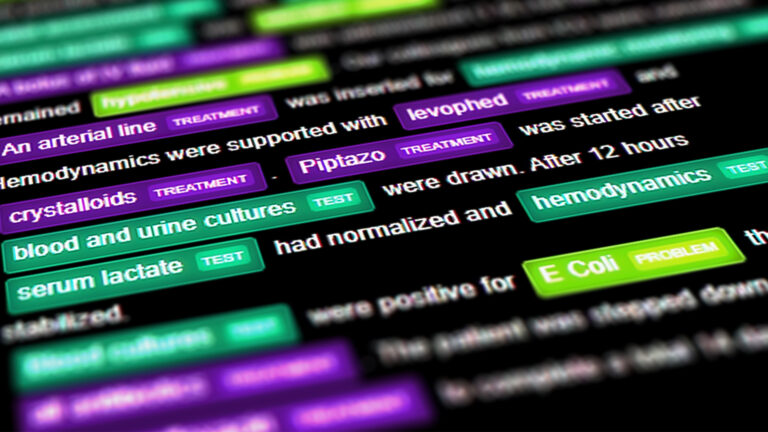 Discover tools to translate unstructured data to structured data to help healthcare organizations harness relevant insights and improve healthcare delivery and patient experiences.
Discover tools to translate unstructured data to structured data to help healthcare organizations harness relevant insights and improve healthcare delivery and patient experiences.
Natural language processing (NLP) can be defined as the combination of artificial intelligence (AI), computer science, and computational linguistics to understand human communication and extract meaning from unstructured spoken or written material.
NLP use cases for healthcare have increased in the last few years to accelerate the development of therapeutics and improve quality of patient care through language understanding and predictive analytics.
The healthcare industry generates vast amounts of unstructured data, but it is difficult to derive insights without finding ways to structure and represent that data in a computable form. Developers need the tools to translate unstructured data to structured data to help healthcare organizations harness relevant insights and improve healthcare delivery and patient care.
Transformer-based NLP has emerged as a paradigm shift in the performance of text-based healthcare workflows. Because of its versatility, NLP can structure virtually any proprietary or public data to spark insights in healthcare, leading to a wide variety of downstream applications that directly impact patient care or augment and accelerate drug discovery.
NLP for drug discovery
NLP is playing a critical role in accelerating small molecule drug discovery. Prior knowledge on the manufacturability or contraindications of a drug can be extracted from academic publications and proprietary data sets. NLP can also help with clinical trial analysis and accelerate the process of taking a drug to market.
Transformer architectures are popular in NLP, but these tools can also be used to understand the language of chemistry and biology. For example, text-based representations of chemical structure such as SMILES (Simplified Input Molecular Line Entry System) can be understood by transformer-based architectures leading to incredible capabilities for drug property evaluation and generative chemistry.
MegaMolBART, a large transformer model developed by AstraZeneca and NVIDIA, is used for a wide range of tasks, including reaction prediction, molecular optimization, and de novo molecule generation.
Transformer-based NLP models are instrumental in understanding and predicting the structure and function of biomolecules like proteins. Much like they do for natural language, transformer-based representations of protein sequences provide powerful embeddings for use in downstream AI tasks, like predicting the final folded state of a protein, understanding the strength of protein-protein or protein-small molecule interactions, or in the design of protein structure provided a biological target.
NLP for clinical trial insights
Once a drug has been developed, patient data plays a large role in the process of taking it to market. Much of the patient data that is collected through the course of care is contained in free text, such as clinical notes from patient visits or procedural results.
While these data are easily interpretable by a human, combining insights across clinical free text documents requires making information across diverse documents interoperable, such that the health of the patient is represented in a useful way.
Modern NLP algorithms have accelerated our ability to derive these insights, helping to compare patients with similar symptoms, suggesting treatments, discovering diagnostic near-misses, and providing clinical care navigation and next-best-action prediction.
NLP to enhance clinical experiences
Many patient interactions with the hospital system are remote, in part due to the growing use of telehealth services that stemmed from COVID-19. Those telehealth visits can be converted into structured information with the help of NLP.
For physicians and surgeons, speech to text capabilities can turn verbal discussions with patients and clinical teams into text, which can then be stored in electronic health records (EHR). Applications include summarizing patient visits, catching near-misses, and predicting optimal treatment regimens.
Removing the burden of clinical documentation for each patient’s visit allows providers to spend more time and energy offering the best care for each patient, and simultaneously reduces physician burnout. NLP can also help hospitals predict patient outcomes such as readmission or sepsis.
Learn more about NLP in healthcare
View on-demand sessions from the NVIDIA Healthcare and Life Sciences NLP Developer Summit to learn more about the use of NLP in healthcare. Session topics include best practices and insights for applications from speech AI in clinics to drug discovery.
Browse NVIDIA’s collection of biomedical pre-trained language models, as well as highly optimized pipelines for training NLP models on biomedical and clinical text, in the Clara NLP NGC Collection.
